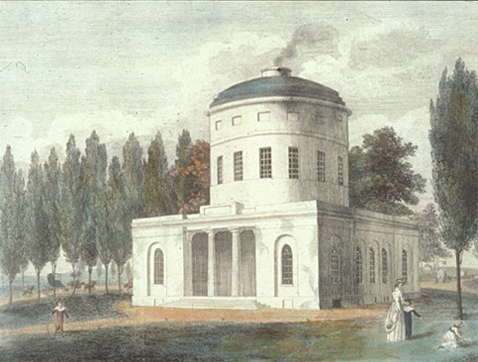Center Square Pump House
William Birch
Courtesy Independence National Historical Park, Karie Diethorn, Chief Curator, and with the kind assistance of library technician Andrea Ashby Leraris.[1]The prints in the INHP collection, which originated in various portfolio sets that preceded Birch’s book, The City of Philadelphia, in the State of Pennsylvania North America, as it appeared in … Continue reading
Benjamin Latrobe’s white marble Pump House, soon after it was built in 1799-1801, became a favorite gathering spot, a pleasant stroll or ride from downtown. Steam engines pumped water from a basin in the Schuylkill River through a long brick tunnel to Center Square, where another pump carried it to the holding tanks atop the building. Water from the storage tanks of the Pump House then was gravity-fed (at first by wooden pipes) to subscribers. Four breweries, a sugar refinery, 37 hydrants and 63 houses were supplied by the time of 1802-03 strolls. Given the socioeconomic status of his hosts, Lewis probably enjoyed the service of this landmark water system. Mahlon Dickerson‘s diary tells us that he and his friend Meriwether Lewis took many walks out to Center Square in 1802-03 as well as 1807.
The ten acres of Center Square itself had previously been the site of a Friends meeting house, a makeshift racetrack, and a Revolutionary Era drill field. The steam-powered pumps of the pump house proved undependable, and the facility was abandoned in 1811 in favor of a new one atop Morris Hill. Latrobe’s structure was demolished in 1828. The present City Hall, completed in 1901, obliterated all traces of it.
Although much remained to be learned about the biological connections between water pollution and human diseases,[2]In 1799 Noah Webster (1758-1843), upon whose Compendious Dictionary of the English Language (1806), we have relied numerous times in Discovering Lewis & Clark, published A Brief History of … Continue reading and although it would be many years before the entire city had access to pure water, the completion of the Water Works in 1800 helped to reduce the threat of epidemics and provided a foundation for continued urban growth.
Experience the Lewis and Clark Trail
The Lewis and Clark Trail Experience—our sister site at lewisandclark.travel—connects the world to people and places on the Lewis and Clark Trail.
Plan a trip related to Center Square Pump House:

Notes
| ↑1 | The prints in the INHP collection, which originated in various portfolio sets that preceded Birch’s book, The City of Philadelphia, in the State of Pennsylvania North America, as it appeared in the Year 1800, measure approximately 18 by 14½ inches. |
|---|---|
| ↑2 | In 1799 Noah Webster (1758-1843), upon whose Compendious Dictionary of the English Language (1806), we have relied numerous times in Discovering Lewis & Clark, published A Brief History of Epidemic and Pestilential Diseases with the Principal Phenomena of the Physical World, Which Precede and Accompany Them, and Observations Deduced from the Facts Stated, 2 vols. (Hartford, Conn., 1799). |

